Understanding the New Holland Square Baler: A Complete Guide
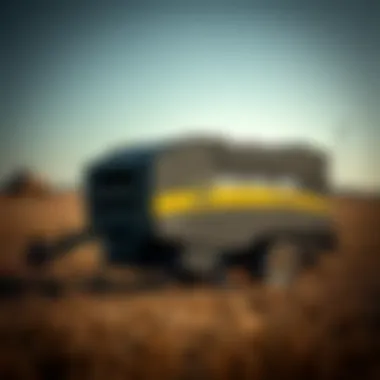
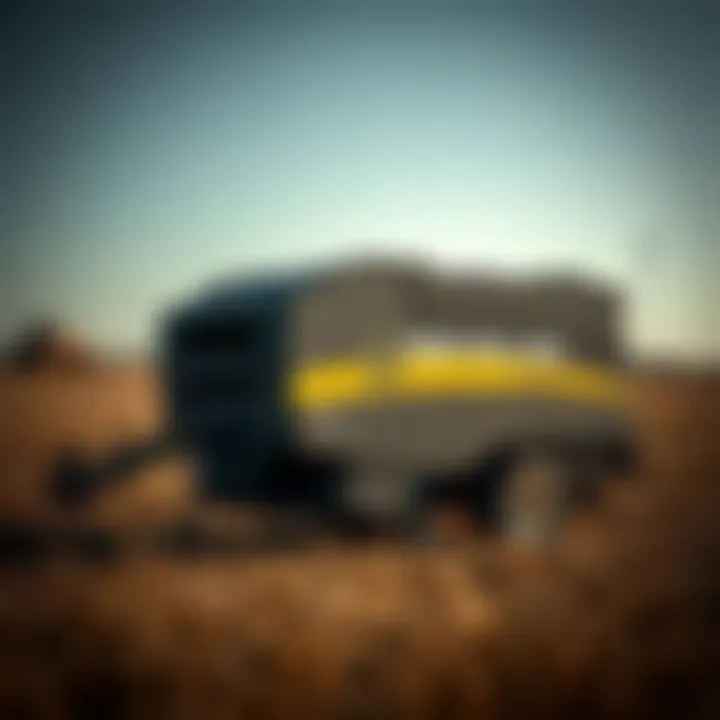
Intro
The agricultural landscape is in a continuous state of flux, chiefly influenced by advancements in machinery and technology. Among these innovations, the New Holland square baler stands out as a significant tool for farmers. It revolutionizes the process of hay production and contributes to efficient crop management. Understanding the functionality and specifications of this machinery is not just a concern for seasoned farmers but also essential for newcomers diving into the world of agriculture. This article serves as a beacon, illuminating the intricate workings and benefits of the New Holland square baler, while also exploring its contributions to sustainable farming and modern agronomy practices.
Topic Overview
Definition and Importance
The New Holland square baler is a piece of agricultural equipment designed specifically for the baling of hay and straw into compact, rectangular bundles. Its primary function is to compress and bind these materials into bales, making them easier to handle, transport, and store. This device plays a crucial role in hay production, allowing farmers to efficiently gather and compress their crops, thus reducing waste and optimizing yield. In essence, it transforms bulk material into an organized, manageable form, contributing significantly to farm efficiency and productivity.
Brief History and Evolution
The advent of the baler can be traced back to the early 19th century when the first manual baling presses appeared. However, it was not until the introduction of mechanized versions that the true potential of baling began to flourish. New Holland, founded in 1895, has been pivotal in this evolution. Their square baler, which gained popularity in the 20th century, introduced several enhancements that increased bale size, durability, and ease of use. Over the years, technological upgrades have included improved knotting mechanisms and automated features that streamline operation, helping farmers save both time and labor.
Key Techniques and Innovations
Sustainable Farming Practices
In today's world, sustainability is not just a buzzword; it's a necessity. The New Holland square baler promotes sustainable farming practices by reducing the carbon footprint of hay production. With its efficient design, it enables maximum use of resources while minimizing waste. Farmers can now produce more bales per hour, which translates to lower fuel consumption and reduced emissions.
Additionally, integrating this baler into the farming process supports crop rotation and land management strategies that preserve soil health. The importance of implementing sustainable methods cannot be overstated, as it aligns agricultural practices with modern ecological responsibilities.
Advanced Agronomic Technologies
With the rise of precision agriculture, the New Holland square baler has incorporated advanced technologies that enhance its functionality. Features like moisture sensors help farmers determine the optimal time for baling. This not only ensures high-quality bales but also aids in efficient drying and storage. Furthermore, some models now offer compatibility with out-of-the-box agronomic software, allowing farmers to integrate baling data into their overall farm management systems.
Practical Applications
Step-by-Step Guides
Understanding how to operate the New Holland square baler effectively is key to maximizing its potential. Here’s a brief overview of the steps involved:
- Preparation: Ensure the baler is in good working condition and the necessary adjustments are made according to the type of forage being baled.
- Loading and Feeding: Load the machine with the cut hay or straw, ensuring there are no obstructions in the feed chamber.
- Baling Process: Activate the baler and monitor its operation. Keep an eye on the knotting mechanism, as it is crucial for bales to remain intact.
- Bale Ejection: Once a bale is formed, it will be ejected out of the rear of the baler. It's important to position bales properly for easier handling and transport.
Case Studies or Real-World Examples
Farmers around the globe have recognized the New Holland square baler as an asset in their agricultural arsenal. For example, a ranch in Kansas reported a 20% increase in productivity after incorporating the latest square baler model into their hay production process. They noted improved bale quality and reduced labor costs, affirming the baler's effectiveness.
Such testimonials underscore the significance of understanding and utilizing modern agricultural machinery to keep pace with evolving agricultural demands.
Prelude to Square Balers
Square balers play a pivotal role in modern agriculture, transforming towering fields of dry grass and forage into manageable, neatly packed bales. The efficiency they bring to the hay-making process is fundamental to farmers aiming for high productivity and streamlined operations. Understanding square balers is not merely about their mechanical components; it's about appreciating how these machines impact the workflow on a farm long before the first cow chews on the freshly baled hay.
Understanding the Basics
At their core, square balers are designed to gather, compress, and bind grass, hay, or straw into bales that are uniform in shape and size. This task may seem straightforward, yet it involves a sophisticated interplay of mechanics that ensures the product's integrity during and after the baling process. Farmers benefit from using square balers, as they provide ease of handling and transportation, significant space-saving advantages, and precise control over bale weight.
The operational capabilities of these balers can vary, making it essential for users to comprehend their basic principles. Typically, a square baler consists of several parts: a pickup mechanism to gather the fodder, a compression chamber to compress it into the desired form, and a binding system to secure the bales with twine or netting. Getting accustomed to these components helps farmers maximize their use of equipment and optimize their baling cycles.
Historical Significance of Baling
The history of baling machinery mirrors the evolution of agricultural practices. Although basic baling techniques date back centuries, the first true balers emerged during the mid-19th century, revolutionizing how farmers processed hay and straw. Before these innovations, manual labor comprised the bulk of the farming workload, often leading to inefficient storage and transport of foraged materials.
Baling machines, especially square balers, fundamentally changed this. The advent of mechanized balers allowed for quicker harvesting, reducing labor costs and time spent in the fields. Farmers could produce more in less time, leading to enhanced food production and sustainability in agricultural practices. Imagine a world where a single afternoon could result in tens of thousands of bales instead of days spent lugging hand-formed stacks around the property. This has enabled farms to scale operations and improved overall productivity, demonstrating how technology can dramatically reshape an industry's landscape.
"Baling is to farming what seasoning is to cooking; it elevates the raw product to a state of usability and efficiency."
With such significance, it is clear that square balers are not just machines but crucial assets that continue to evolve—reflecting the changing needs of the agricultural sector and technological advancements.
Understanding square balers lays the foundation for exploring the specific features and advantages provided by the New Holland models, which are cherished for their reliability and cutting-edge innovations.
Overview of New Holland
When it comes to square balers, one cannot discuss the landscape of agricultural machinery without mentioning New Holland. This company has carved a niche for itself in the world of farming equipment, often emerging as a pivotal player shaping the future of agronomy. The significance of understanding New Holland lies not just in its reputation but also in the value it brings to the agricultural community.
The essence of New Holland goes beyond the mere manufacturing of machines. Their square balers, in particular, reflect years of innovation, experience, and deep understanding of farmers’ needs. By delving into the company's history, one gets a clearer picture of the evolution of their products and how they've continuously adapted to meet the ever-changing demands of the market.
Company History and Development
New Holland originated in the early 20th century, specifically in 1895 when it was established in a small town in Pennsylvania. Initially, the company focused on producing threshing machinery and soon evolved to encompass more sophisticated agricultural equipment. Over the decades, New Holland has undergone various transformations, including mergers and acquisitions, which expanded its product range and global reach. For instance, the acquisition of the Fiat Group in the 1990s allowed the company to tap into greater technological prowess, fostering advancements in their balers and other machinery.
Their strategic moves—like the introduction of round balers and innovation in precision farming—demonstrate New Holland’s commitment to meeting farmers' requirements. The development of the square balers, particularly, not only stands as a testament to their engineering excellence but also reflects their proactive approach to sustainability and efficiency. The journey of New Holland is one of resilience, adaptation, and unwavering focus on quality.
Innovations in Agricultural Machinery


As technology continues to reshape the agricultural landscape, New Holland has been at the forefront of implementing cutting-edge innovations in their square balers. These improvements are not merely about enhancing performance; they're about providing solutions that address the nuanced challenges faced by modern farmers.
For instance, the introduction of automation technologies integrated into balers has streamlined operations significantly. Farmers no longer need to monitor each process intricately; instead, smart systems can help in optimizing pressure, ensuring consistency in bale density, and, ultimately, maximizing productivity. The integration of IoT devices provides real-time data on machine performance, allowing for immediate adjustments that can prevent costly downtime.
Moreover, New Holland emphasizes eco-friendly solutions in their innovations. The development of more fuel-efficient engines and the utilization of lighter materials demonstrate a conscious effort to lessen the environmental footprint. As climate change becomes an inescapable reality, these technological advancements position New Holland not just as a machinery producer, but as a responsible steward of the land.
In summary, the overview of New Holland encapsulates a journey of legacy and forward-thinking in agricultural machinery. Understanding its historical underpinnings and innovative strategies is essential for anyone who intends to navigate the complexities of modern farming with an eye towards efficiency and sustainability.
Features of New Holland Square Balers
The features of New Holland square balers are fundamental in understanding why these machines have become a staple for both commercial and small-scale farmers. These machines not only streamline the hay production process but also ensure that farmers can achieve consistent quality in their output. From the crafted design to how they function, each aspect of New Holland square balers has been developed with meticulous attention to detail, proving instrumental in maximizing productivity and reducing labor costs.
Design and Engineering
When it comes to design, New Holland has made a name for itself through innovative engineering. The balers are typically constructed with strong materials that withstand the rigors of fieldwork. This robustness ensures longevity, which is a critical factor for farmers looking to make a long-term investment.
The geometry of these balers allows for efficient feeding and compaction of material. For instance, the intake system has been meticulously engineered to handle varying crop types and conditions without jamming or creating excessive wear on the machinery.
Not only do these balers score high on durability, but their compact layout also facilitates maneuverability. Farmers often operate in tight spaces, and New Holland’s adept design aids in navigation, thus enhancing field efficiency.
Operational Mechanism
The way New Holland square balers operate is perhaps their most impressive aspect. At the heart of their mechanism is the piston-driven system that compresses the crop into bales. What sets these balers apart is their ability to adjust the density and size of the bales according to specific farming needs. This flexibility helps farmers balance between transport ease and storage space efficiency.
One notable feature is the auto-latch tying system, which ensures that bales are securely tied without operator intervention. This automates a crucial part of the baling process, reducing labor costs and increasing throughput. Moreover, the user-friendly controls enable operators to make real-time adjustments depending on conditions in the field.
Capacity and Efficiency Metrics
Capacity is a defining characteristic of any baler, and New Holland does not disappoint. Most models are designed to handle large volumes of material within less time. When looking at efficiency metrics, farmers can expect to produce bales at a rate significantly higher than many competitors.
For instance, depending on the model and crop condition, New Holland square balers can produce between twenty to fifty bales an hour. This impressive output combined with features like variable chamber size means that every farmer can tailor the operation to meet their specific requirements.
Additionally, their commitment to energy efficiency is evident. The operational design minimizes fuel consumption, a consideration that is becoming increasingly important as energy prices remain volatile.
New Holland's square balers not only simplify the baling process but also empower farmers with the tools to optimize their operation. By integrating innovative design, effective mechanisms, and capacities tailored to various agricultural needs, these machines establish themselves as invaluable companions in the world of modern farming.
"A well-built baler can mean the difference between a profitable harvest and a significant loss."
Types of Square Balers Offered by New Holland
Understanding the different types of square balers provided by New Holland is crucial for farmers and agricultural enthusiasts looking to optimize their hay production and manage costs effectively. Choosing the right baler can streamline operations, boost efficiency, and ultimately affect the quality of the end product. New Holland balances technology advances with simplicity, catering to a wide range of needs in the agricultural sector.
Small Square Balers
Small square balers from New Holland are designed for those who prioritize maneuverability and compact operation. They are often favored by small farms or operations focusing on niche markets, like specialty hay production or livestock feed. The compact size allows for easy transport on narrower paths or winding trails, making them versatile to use on varied terrains.
Key benefits of small square balers include:
- Ease of Operation: Typically easier to operate for beginners, thanks to simpler mechanisms and controls.
- Cost-Effective: Lower initial investment costs make these machines accessible for smaller operations.
- Space Efficiency: Their compact size requires less storage space when not in use.
The New Holland model BB50 is a prime example of a small square baler that has carved out a niche for itself in the market. Its design focuses on efficiency without sacrificing performance. The bale size is convenient for handling and allows for a quicker turnaround during the baling process. The simplicity of the design means users spend less time on maintenance, making it attractive for small-scale operations.
Large Square Balers
On the other side of the coin, New Holland's large square balers are tailored for more extensive farming operations, where production volumes are higher. These balers can handle large quantities of material, producing bigger bales that are easier to handle and transport. They become crucial in time-sensitive environments during haymaking seasons.
Some advantages of large square balers include:
- Increased Output: Larger balers produce bigger bales, which means fewer bales to manage overall, saving time in the field and storage.
- Robust Construction: Designed to withstand the rigors of heavy-duty use, these balers are built with robust materials, enhancing their longevity.
- Advanced Technology: Many large square balers come equipped with smart technologies that can optimize the baling process, from automatic bale tying to real-time monitoring systems.
The New Holland model BB9000 exemplifies the innovation in large square balers. It combines high-capacity performance with precision and reliability, equipped with features like enhanced pick-up mechanisms and advanced knotting systems, which minimize downtime and maximize productivity during critical harvest times.
In summary, choosing between small and large square balers from New Holland ultimately boils down to the specific needs of the farmer, their operational scale, and whether they lean towards flexibility or high output. Knowing these distinctions can make all the difference in selecting the right piece of equipment for successful agricultural practices.
Advantages of Using New Holland Square Balers
The use of New Holland square balers presents numerous advantages that resonate well with both amateur and seasoned farmers alike. In an industry driven by efficiency and productivity, understanding these benefits is crucial for anyone looking to hone their skills in agricultural practices. This section dives into the specific elements that make New Holland square balers a staple in modern farming operations. From increased productivity to cost-effective operational strategies, these machines play a pivotal role in enhancing farming outcomes.
Enhanced Productivity
New Holland square balers are engineered to maximize efficiency in the baling process. One of the significant benefits is the ability to create dense and uniform bales, which can ease the handling and storage during the subsequent stages of hay production. There’s no denying that a well-made bale translates to less wastage, which can be economically beneficial. With features like adjustable bale density and automatic tie systems, farmers can optimize their output without sacrificing quality.
Moreover, these balers can operate at high speeds, often allowing fields to be covered more quickly than traditional balers. This is especially vital during the harvest season when time is of the essence, and weather conditions can shift unexpectedly. The fact that these machines can function seamlessly in various conditions—wet or dry—gives them an edge that many farmers find indispensable.
To illustrate, consider a farmer who was able to double his output during the peak season by transitioning to a New Holland square baler, all while reducing the number of labor hours required. The machine allowed for efficiency in both time and energy usage.
Cost-Effectiveness in Operations
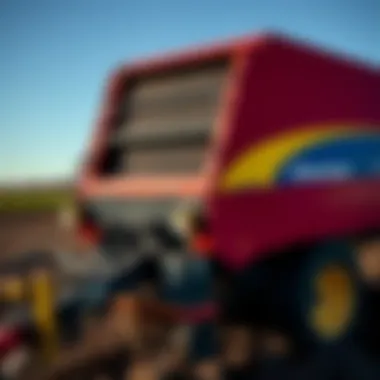
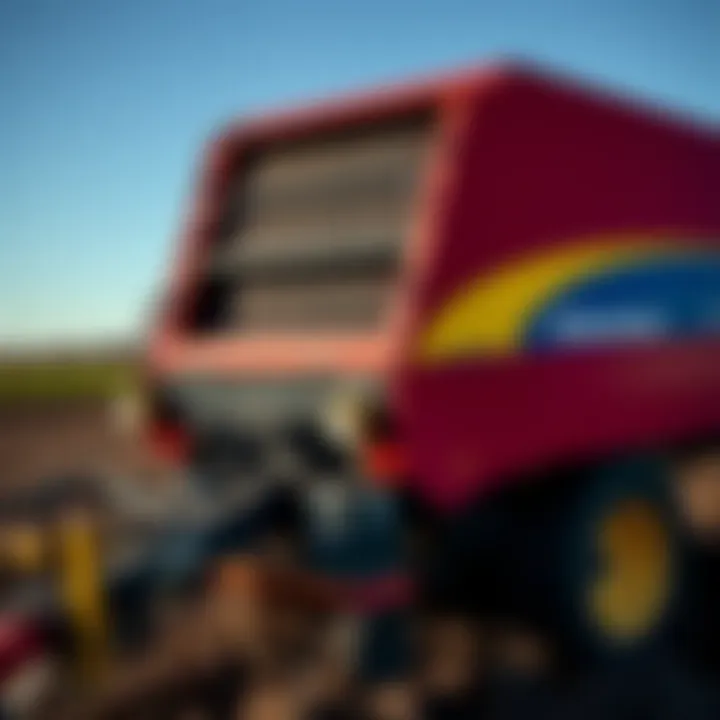
When it comes to farm management, the return on investment is always a critical consideration. New Holland square balers deliver on this front as well, making them a smart choice for cost-conscious farmers. First off, their durability and low maintenance requirements mean they won't drain your budget over time.
Regular wear and tear is a reality for any machinery, but the rugged construction of New Holland balers means they can last through extensive use without needing constant repairs. The parts are designed to be readily available, which averts long downtimes—a boon for any operation.
Investing in a New Holland square baler also implies that farmers can potentially reduce their labor costs. Since these balers can automate various processes, fewer hands are necessary for the same task, which can lead to significant savings over time.
In summary, the dual advantage of enhanced productivity and cost-effectiveness in operations makes New Holland square balers a sound investment for individuals looking to elevate their farming practices. With features designed to address the everyday challenges faced in agriculture, these machines support efficiency and sustainability in a demanding sector.
Technological Advancements
Technological advancements in the agricultural sector have radically altered farming practices, and the New Holland square baler stands as a prime example of this shift. The integration of cutting-edge technologies not only enhances the efficiency and effectiveness of baling but also adapts to the evolving needs of modern farmers. By employing smart solutions, manufacturers allow farmers to harvest more crops, manage resources better, and reduce labor costs. With these innovations, New Holland stays relevant in the competitive market, consistently delivering balers that meet the high demands of productivity and sustainability.
Integration of Smart Technologies
In the realm of agricultural machinery, smart technologies herald a transformation that is both profound and necessary. New Holland has embraced these advancements through the inclusion of systems such as telematics and automation in its square balers.
- Telematics: Farmers can gather data on the baler's performance in real-time. The telematics system provides insights into operational metrics like bale count, moisture readings, and machine diagnostics. Being aware of these metrics helps farmers make more data-driven decisions, directly influencing the quality of hay produced.
- Automation: Many models now come equipped with automated functions that streamline operation. This includes features such as automatic tying of bales and self-level adjustment, reducing the need for constant manual oversight. As a result, workers can focus on other crucial tasks, maximizing productivity on the farm.
These smart systems essentially create a feedback loop where data gathered during baling can be used for continuous learning and optimization.
Impact on Farming Practices
The integration of smart technology through the New Holland square baler has profound implications on farming practices. With these advancements:
- Farmers can achieve better quality control, ensuring that the moisture content and density of bales are optimal. This precision leads to higher quality forage that not only reduces wastage but also improves livestock health.
- Resource management improves, as farmers can monitor their usage of inputs like fuel and labor. This leads to better cost control and enhances sustainability, aligning with modern environmental standards.
"By leveraging technology, we’re not just increasing production; we’re reshaping the entire agricultural experience and making it more sustainable for future generations."
Furthermore, the data-driven insights gleaned from using these technologies allow for predictive maintenance. Farmers can address potential issues before they escalate, resulting in reduced downtime during peak harvesting seasons. This agility proves vital in maintaining operational continuity.
As the landscape of agriculture shifts towards more sustainable practices, the New Holland square baler emerges not only as a tool of productivity but also as a partner in cultivating efficiency, quality, and sustainability. With these technological advancements, farmers are poised to meet the growing demands of a dynamic agricultural environment.
Usage Guidelines
Usage guidelines for New Holland square balers are integral to maximizing the efficiency and lifespan of this crucial agricultural machinery. Understanding how to properly handle and operate the baler can lead to not just better bale quality but also reduced wear and tear on the equipment. The significance of adhering to these guidelines cannot be overstated; they help ensure a smoother operation and a safer workplace.
Proper Handling and Operation
To get the most out of your New Holland square baler, adequate understanding of its operational intricacies is vital. First, familiarity with the baler's control mechanisms is essential. Knowing how to adjust the settings for different types of forage or crop can yield bales that are more uniform in size and density.
Before beginning any task, ensure that all safety and operational manuals are on hand. It is advisable to conduct a thorough check of the baler before each use, looking for any wear or damage that could affect performance. Such a pre-operation checklist might include:
- Confirming proper lubrication of moving parts.
- Checking that the twine or net wrap systems are functioning correctly.
- Inspecting the pick-up and feed auger to ensure they are free of obstruction.
When operating the baler, maintain a consistent and appropriate speed. This helps avoid overloading the machine and can keep the crop moving smoothly into the baling chamber. Additionally, keep an eye on the moisture level of the forage. Excess moisture can lead to spoilage, while insufficient moisture can cause the bales to be too brittle.
Best Practices for Efficiency
Efficiency is key to successful farming operations, and using a New Holland square baler effectively can dramatically enhance productivity. Consider integrating the following best practices into your work routine:
- Utilizing Technology: Equip your baler with optional monitoring systems. These systems can provide real-time data on pressure and density, allowing operators to make immediate adjustments.
- Routine Maintenance: Stick to a maintenance schedule. Regularly scheduled checks can help catch issues before they escalate. Be particularly vigilant about the condition of belts and hydraulic systems.
- Optimizing Field Conditions: Choose the best time of day for baling. Grass tends to be drier in the early afternoon, which can enhance the quality of the bales produced.
- Training Operators: Ensure that all operators receive comprehensive training on both the theoretical and practical aspects of the baler. Well-trained personnel can significantly reduce the likelihood of mistakes that could lead to inefficiencies or accidents.
Proper usage and handling of New Holland square balers not only boost operational efficiency but also enhance the overall health of your machinery.
By following these guidelines, farmers can elevate not only their output but also the value derived from their equipment. Keeping abreast of best practices separates successful operations from those that struggle.
Maintenance and Care
In the realm of agricultural machinery, proper maintenance and care of implements like the New Holland square baler cannot be overstated. Keeping your baler in peak condition ensures not only longevity but also operational efficiency during critical harvest seasons. A well-maintained baler functions seamlessly, thus enhancing productivity and mitigating unexpected downtimes. Additionally, routine care can help in maintaining the quality and consistency of the bales produced. Here’s a closer look at how to navigate routine maintenance and troubleshoot common issues, ensuring your baling operations run smoother than a well-oiled machine.
Routine Maintenance Tasks
Routine maintenance tasks might seem like a chore, but they play a vital role in the ongoing performance of your New Holland square baler. Here are several tasks that should be a staple in your maintenance plan:
- Daily Inspections: Before starting work each day, inspect critical components of the baler. Check for loose bolts, worn belts, and any visible signs of wear and tear. A thorough inspection may prevent minor issues from spiraling into major problems.
- Clean the Baler: Hay, dust, and debris can accumulate in and around the baler. Regular cleaning helps prevent issues related to rust and mechanical blockage. Take time after each use to remove these materials.
- Lubrication: Ensure all moving parts are lubricated according to the specifications in the user manual. Lubrication reduces friction, thereby extending the lifespan of parts like rollers and gears.
- Monitor Components: Keep an eye on key components like the pickup, knotters, and knives. Look for any signs of malfunction or wear, which might require immediate attention.
Maintaining a schedule for these tasks can keep your baler running efficiently and minimize repairs, saving time and money in the long run.
Troubleshooting Common Issues
Even with diligent maintenance, issues can arise with the New Holland square balers, and knowing how to troubleshoot these problems is essential. Here are some common issues and their solutions:
- Bale Formation Problems: If bales are not forming properly, check the knotter system. Debris buildup in the knotters is a frequent cause of malfunction. Ensure that the knotting mechanism is clean and functioning well.
- Uneven Bales: This often points to an issue with the pickup system or the tension on the baler. Make sure the pickup is clean and free of obstructions. Adjust the tension settings according to the type of material being baled.
- Power Issues: If the baler is not receiving adequate power, the problem might lie in the tractor connection. Inspect the PTO (Power Take-Off) shaft for damage or misalignment.
"Regular maintenance not only ensures the durability of the machine but also guarantees the safety of both the operator and the environment."

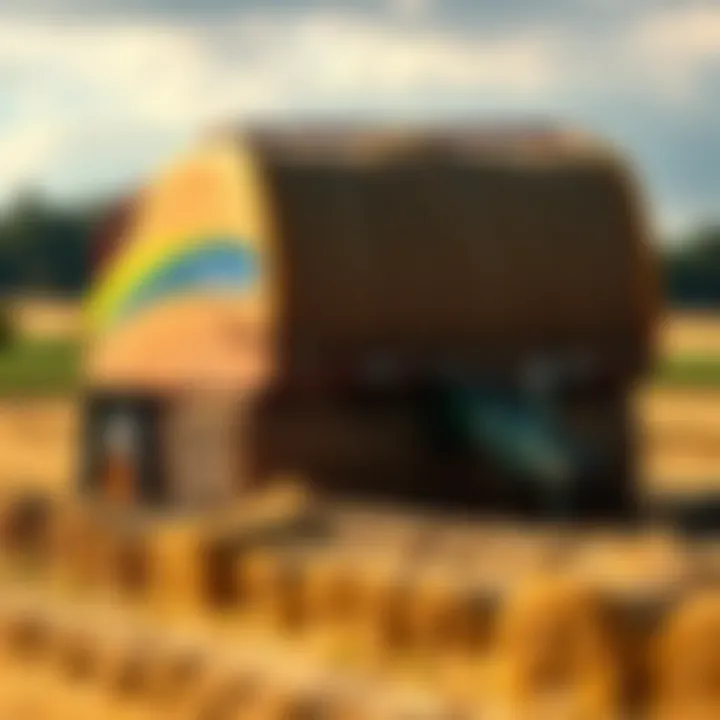
- Poor Hay Quality: If the bales appear to be of subpar quality, investigate the moisture levels in the hay and check the cutter bar for dull blades or blockages.
When issues arise, referencing the user manual for guidance on specific solutions or adjustments is beneficial. However, don't hesitate to consult an experienced technician when faced with persistent problems.
For additional reading and resources, you can explore: Wikipedia on Square Balers or Agricultural FAQs for insights into best farming practices.
Environmental Considerations
Understanding environmental considerations in agriculture is increasingly vital as we face climate change and resource depletion. The methods and tools we use in farming, like the New Holland square baler, have a direct impact on the land, air, and water. This section delves into how modern balers can promote sustainable practices, mitigate environmental harm, and align with eco-friendliness.
Sustainability in Agriculture
Sustainability is more than a buzzword; it's a necessity in modern agriculture. The New Holland square baler incorporates features that reflect sustainable practices, helping to protect the environment while still meeting the demands of production.
Using a square baler efficiently reduces waste during the hay-making process. Old methods often led to substantial loss of nutrients and fibers, translating to less efficient use of materials. Today, these balers are designed with precision in mind, ensuring that more of the product is used effectively.
Key benefits of sustainability include:
- Resource Conservation: Baling helps in preserving soil quality and reducing erosion, thanks to its efficient collecting and compacting process, which maintains integrity in the fields.
- Biodiversity Promotion: By choosing to implement sustainable practices, farmers can maintain diverse ecosystems. Well-managed fields support various species of plants and wildlife.
- Climate Mitigation: The reduced carbon footprint associated with effective baling processes contributes positively to combating climate change.
Through the utilization of efficient machinery, farmers can produce high-quality forage while minimizing their impact on natural resources, creating a win-win situation.
Minimizing Environmental Impact
To ensure that agricultural practices are not harming the environment, it's critical to look at the operational aspects of the New Holland square baler and its associated practices.
To start with, proper operation and maintenance of the baler play a crucial role in minimizing emissions. For instance, ensuring that the machine runs at optimal capacity reduces unnecessary fuel consumption and emissions.
Moreover, the features of the New Holland square baler allow for precise cutting and bundling, which can help in:
- Reducing Field Traffic: Less time spent in the field means lower soil compaction and disturbance, preserving the soil structure and its biological activity.
- Utilizing Advanced Technology: Incorporating GPS and telemetry can help farmers determine the best times for baling, thus reducing the risk of weather-related losses and ensuring better conservation of moisture.
- Implementing Crop Rotation Strategies: By using the baler for multiple purposes over time, such as clearing residuals between crops, farmers can aid in nutrient cycling and avoid harmful accumulation of waste products.
"New Holland continues to lead the charge in integrating eco-friendly technologies into their equipment, redefining what productivity means in a sustainable world."
These aspects highlight how technology in the agricultural sector is evolving to tackle environmental challenges. As farmers adapt to these tools, they not only harvest crops but also contribute to the greater good of preserving the earth.
For further insights on sustainable agricultural practices, consider checking resources like Sustainable Agriculture Research and Education or USDA Organic.
By understanding and implementing effective practices, both farmers and consumers can work towards a more sustainable future.
Future Prospects of Square Baling Technology
The future of square baling technology holds a wealth of possibilities. As the agricultural landscape continues to evolve, these advancements are set to play a crucial role in meeting the demands of modern farming. With a careful blend of innovation and practicality, the developments in this sector promise to enhance productivity, sustainability, and efficiency.
Evolving Agricultural Needs
Agricultural needs today are nothing like they were a few decades back. Farmers face pressures from population growth, climate change, and economic shifts. Consequently, the tools and technologies they relied on must also adapt. Square balers, particularly from manufacturers like New Holland, are seeing upgrades that cater to these changing requirements.
- Increased Demand for Sustainability: There's an increasing call for more environmentally friendly practices. New Holland is exploring options that reduce fuel consumption and emissions in their square balers. This is a game changer for farmers who wish to align their practices with sustainability goals.
- Automation and Precision Farming: As automation takes a stronger foothold in agriculture, the future square balers are likely to integrate more advanced technologies. Farmers can expect features like automated feeding systems and smart algorithms that dictate optimal baling conditions, enhancing yield and reducing waste.
- Customization and Versatility: The demand for customized machinery is on the rise. Future balers might offer more modular options, allowing farmers to select features that fit specific needs, from small family farms to large-scale operations.
Potential Innovations on the Horizon
Considering the lightning-fast pace of technological advancements, it’s clear that square baling will see some interesting innovations on the horizon.
- Smart Sensors and IoT Integration: Imagine balers equipped with sensors that monitor bale density in real-time. The Internet of Things (IoT) could allow for remote monitoring of performance metrics, alerts for maintenance needs, and data analytics to drive informed decision-making.
- Advanced Materials: The materials used in baler construction might evolve as well. New lightweight yet durable materials could enhance mobility and ease of use while also extending the machine's lifespan.
- Augmented Reality Training: Harnessing augmented reality could streamline training for operators. Users might receive real-time visual guidance on best operational practices through AR glasses. This would not only save time but also improve safety and efficiency.
- Data-Driven Like Never Before: Data collection can dramatically improve the way balers are used. With ongoing advancements, farmers might find their equipment linked to predictive models that suggest optimal baling times and conditions based on weather patterns and soil conditions.
"The true potential of square baling technology lies not just in innovation, but in the tailored solutions it can provide to meet local farmer's unique needs."
It’s certain that as the agricultural world continues to turn, square balers like those from New Holland will evolve. Keeping an eye on these prospects is essential for those looking to invest or improve their operational mechanics. In the grand scheme of agricultural development, the future of square baling technology holds potential that, when harnessed, could redefine the way we approach both farming and ecosystem sustainability.
Ending
The significance of understanding the New Holland Square Baler cannot be overstated. This machine stands at the intersection of tradition and innovation in agriculture, playing a crucial role in the efficiency and sustainability of modern farming practices. By summarizing the key insights discussed throughout the article, we can appreciate not only its operational capacity but also its impacts on broader agricultural methodologies.
Summarizing Key Insights
As we wrap up our exploration of the New Holland square baler, let’s highlight some pivotal elements:
- Efficiency: The design of these balers ensures minimal waste and maximized output, a requirement for today’s farmer facing increasing operational costs and market pressures.
- Versatility: Square balers provided by New Holland cater to various farming sizes and types, allowing farmers to customize their equipment to match specific needs, whether it’s small or large square bales.
- Technological Integration: The incorporation of smart technologies has transformed the functionalities of balers, enhancing precision in operations and easing the workload for farmers.
- Environmental Aspects: Understanding how square baling contributes to sustainability efforts in agriculture helps in reducing the environmental footprint of farming practices.
Overall, these balers encapsulate a blend of engineering excellence and practicality, essential for the successful management of hay production.
Final Thoughts on Square Baling
Reflecting on the journey through this guide, it's clear that the New Holland square baler represents more than just a piece of machinery. It symbolizes progress in farming, marrying human ingenuity with nature’s cycles.
Farmers and enthusiasts must recognize the importance of this equipment as part of the wider agricultural picture. As agricultural needs evolve, so too should the tools and technologies we use; the New Holland square baler is a testament to how modern innovations can enhance traditional practices.
"It’s not just about harvesting crop; it’s about harvesting innovation for a sustainable future."
For further information on agricultural sustainability, one might find valuable insights on resources such as USDA.gov or FAO.org.
Whether you’re a veteran in the fields or just starting out, the New Holland square baler can make a notable difference in your agricultural endeavors. Understanding its features and benefits better informs your choices, leading to smarter farming.



